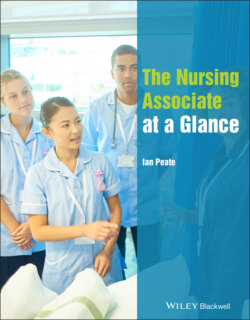Читать книгу The Nursing Associate at a Glance - Ian Peate - Страница 10
Оглавление
Preface
Nursing, being a practice‐based discipline, requires the theoretical knowledge provided to be grounded in practice so as to facilitate professional competence with regard to fitness for practice, purpose, award as well as professional standing.
The role of the Nursing Associate was developed in response to a number of key policies and drivers, including the NHS Five Year Forward Plan (NHS, 2014), Shape of Caring: Raising the Bar (Health Education England (HEE) 2015), Nursing Associate Curriculum Framework (HEE, 2017) and the Skills for Health (2017) Nursing Associate Apprenticeship Standards. The Nursing and Midwifery Council (NMC) confirmed in January 2017 that the Nursing Associate will be a new regulated nursing role, in England, from January 2019.
In response to the NMC’s confirmation that it would become the Nursing Associate regulator, actions needed to be taken to ensure that standards were in place. Standards were produced in 2018 for the Nursing Associate proficiencies (NMC, 2018a) and for Nursing Associate programmes (NMC, 2018b). The NMC revised its Code of Conduct in 2018 to include the Nursing Associate (NMC, 2018c).
Locally, nationally and globally, health and care settings are experiencing complex challenges. There has been an increased demand on services with the imperative that patients receive the right care, at the right time and in the right place. Key to this is the building of new health and care partnerships, integrating care provision and developing new roles. The Nursing Associate role is a response to the need to develop the healthcare support worker role and to offer support to the Registered Nurse. A role in its own right, the Nursing Associate acts as a bridge between, and complements, the unregulated healthcare workforce and the Registered Nurse. Furthermore, it widens access to further career development as a Registered Nurse.
Approved Nursing Associate programmes are aimed at individuals who are employed in health and care settings. Programmes of study have to be flexible, authentic work‐based learning programmes that develop competent, confident and compassionate Nursing Associates who will be proficient in the provision of high‐quality, safe and responsive person‐centred care that traverses the lifespan in a variety of diverse settings. As programmes of study involve learning from practice, and learning in practice, they draw upon the principles of work‐based learning in supportive environments.
The aim of the Nursing Associate programme should be that on completion of their programme the Trainee Nursing Associate will demonstrate passion and confidence in their practice, committed to supporting the holistic delivery of person‐centred care across the life span, embracing the notion of lifelong learning and taking on responsibility for working within their scope of practice.
The six platforms used by the NMC in the Standards of Proficiency for Nursing Associates (NMC, 2018a) have been used to structure the text. Annexes A and B are provided as appendices.
The Nursing Associate at a Glance provides the Trainee Nursing Associate with a revision aid that will support their classroom and practice‐based learning. The text aims to help develop Nursing Associates who are competent, confident and compassionate, providing high‐quality, evidence‐based, holistic, non‐judgemental person‐centred care.
Terminology
The words that are used to describe people are important. The importance of the terms chosen is that they have the potential to create a particular perception of a person that could be positive, encouraging, enriching or destructive and stigmatising.
Alternatives to the term ‘patient’ like ‘clients’, ‘service users’ and ‘consumers’ have arisen as a consequence of attempts to empower patients by transforming their relationships with illness, society and health and social care professions. Where ‘patients’ is used in this text, this also means those people who are in your care and would include service users. In contemporary health and social care, patients are justifiably seen as experts who have valuable lessons to teach practitioners. It should be noted that any form of labelling will always have the potential to do harm.
References
1 Health Education England (HEE) (2015). Shape of caring: Raising the bar. https://www.hee.nhs.uk/sites/default/files/documents/2348‐Shape‐of‐caring‐review‐FINAL.pdf. Last accessed August 2020.
2 Health Education England (HEE) (2017). Nursing Associate Curriculum Framework. https://www.hee.nhs.uk/sites/default/files/documents/Nursing%20Associate%20Curriculum%20Framework%20Feb2017_0.pdf. Last accessed August 2020.
3 NHS (2014). Five Year Forward Plan. https://www.england.nhs.uk/wp‐content/uploads/2014/10/5yfv‐web.pdf. Last accessed August 2020.
4 Nursing and Midwifery Council (NMC) (2018a). Standards of proficiency for nursing associates. https://www.nmc.org.uk/standards/standards‐for‐nursing‐associates/standards‐of‐proficiency‐for‐nursing‐associates/ Last accessed August 2020.
5 Nursing and Midwifery Council (NMC) (2018b). Standards for pre‐registration nursing associate programmes. https://www.nmc.org.uk/standards/standards‐for‐nursing‐associates/standards‐for‐pre‐registration‐nursing‐associate‐programmes/ Last accessed August 2020.
6 Nursing and Midwifery Council (NMC) (2018c). The Code. Professional standards of practice and behaviour for nurses, midwives and nursing associates. https://www.nmc.org.uk/globalassets/sitedocuments/nmc‐publications/nmc‐code.pdf. Last accessed August 2020.
7 Skills for Health (2017). Nursing Associate Apprenticeship Standards. https://haso.skillsforhealth.org.uk/wp‐content/uploads/2017/04/2018.01.12‐L5‐Nursing‐Associate‐ST0508‐Standard.pdf. Last accessed August 2020.
